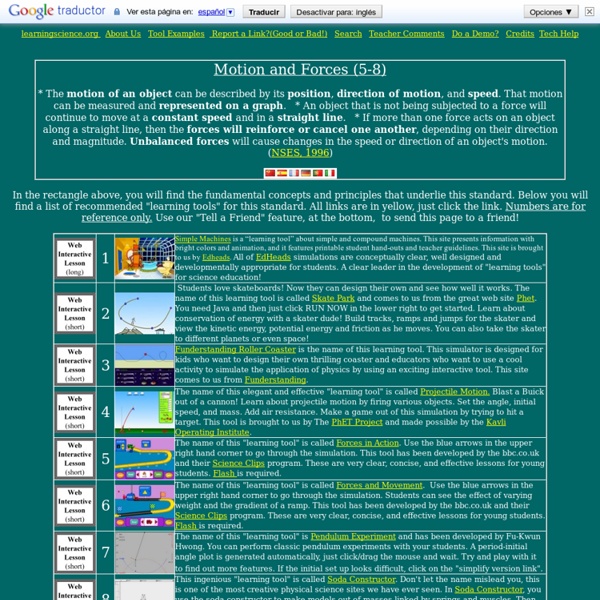



Galileo Drops the Ball - Virtual Experiment In around 1590 Galileo Galilei (1564-1642) climbed up the Leaning Tower of Pisa and dropped some balls to the ground. Two balls of different masses, but of similar shape and density that were released together hit the ground at the same time. Until then it was commonly believed that heavy things fall faster than light things. Many people still believe this, and casual observation of everyday phenomena often does tend to confirm this view. If you drop a brick and a feather at the same time the brick will probably hit the ground first. Galileo’s discovery is important in understanding how parachutes work. Click on the image to the left to try Galileo’s experiment for yourself. Find out more about Galileo Galilei.
Motion: Introduction Motion is one of the key topics in physics. Everything in the universe moves. It might only be a small amount of movement and very very slow, but movement does happen. Don't forget that even if you appear to be standing still, the Earth is moving around the Sun, and the Sun is moving around our galaxy. The movement never stops. Motion is one part of what physicists call mechanics. Acceleration is a twist on the idea of velocity. There are two main ideas when you study mechanics. There are also more complex movements when an object's direction is changing. In order to really understand motion, you have to think about forces, acceleration, energy, work, and mass. Or search the sites for a specific topic.
Acceleration - Physics for Kids! Acceleration is a way to measure how fast something is speeding up. Suppose you are riding your bike. You start out going very slowly, hardly pedaling at all. Now you begin to pedal as hard as you can, to speed up - you are accelerating. If you stop pedaling now, friction will work on your bike tires (and you'll have friction from the air, too), and you'll soon start to go slower. One important cause of acceleration is gravity. The acceleration of Earth's gravity will speed you up at about 9.8 meters per second per second (9.8 m/s2, or 9.8 meters per second squared). Standing on the cliff before you jump, you're going zero meters/second. You can use acceleration to find out the mass of an object, because force = mass x acceleration. Learn by doing - Using bikes to work with the physics of motion To find out more about acceleration, check out these books from Amazon.com or from your library: Or check out this link to the Encyclopedia Britannica's article on accleration. or
Motion: Forces Forces are a big part of physics. Physicists devote a lot of time to the study of forces that are found everywhere in the universe. The forces could be big, such as the pull of a star on a planet. Let's look at the forces acting on that soccer ball before you kicked it. If there is more than one force acting on an object, the forces can be added up if they act in the same direction, or subtracted if they act in opposition. There is one totally important formula when it comes to forces, F = ma. Or search the sites for a specific topic.